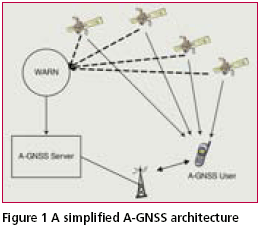
There are many different types of technologies employed in calculating the location of handsets in wireless networks with various levels of success and accuracy. Assisted-GPS (A-GPS) is a positioning technology that is presently used for locating handsets in wireless networks and is gaining traction in the market. An A-GPS server provides assistance data to the handset in order for it to have a low Time to First Fix (TTFF), weak signal acquisition and optimize handset battery use. A-GPS is used as a location technology in isolation or hybridized with other positioning technologies that provide range-like measurements.

Quality hydrographic survey data is essential for efficient maritime development
N R Raut
Assistant Hydrographic Surveyor in Minor Ports Survey Organisation,
Ministry Of Shipping, Road, Transport & Highways.
nrrautahs@yahoo.com
India has long coastline of 7517 kms with 12 major ports and 187 minor & intermediary ports. Major ports all together handled 423 million tones traffic & non–major ports all together …
According to a report by ABI Research, there will be over 240 million GPS-enabled mobile phones in 2008. Many of these phones will find their way into India, which translates into a huge opportunity for the Indian GPS/ GIS industry. But will these millions of GPS enabled handhelds be used for navigation alone? The probability is low…
They went up a hill to fetch a pail of water. Jack fell down and broke his bone and Jill came tumbling after… And now they need medical attention and must locate a medical center soon. How far is the nearest hospital? How do they get there from the accursed hill? What is their current location? They need location-based services (LBS). “What is LBS?” asks Jill….

INDUSTRY | LBS | GPS | GIS | REMOTE SENSING | GALILEO UPDATE
WorldView-1 reaches full operational capability
WorldView-1 is now fully commissed, meets all its requirements, and is delivering imagery to the National Geospatial- Intelligence Agency (NGA) as part of the NextView program. DigitalGlobe will begin taking orders for WorldView-1 imagery from its global resellers, …

INDUSTRY | LBS | GPS | GIS | REMOTE SENSING | GALILEO UPDATE
Satellite imaging for rail navigation
Indian Railways have sanctioned a pilot project, Satellite Imaging for Rail Navigation (SIMRAN), for real time passenger information system by utilizing GPS. This project is being carried out jointly by Research Designs & Standard Organization, Lucknow and Indian …
Raytheon completes final system test for Indian SBAS
Raytheon, USA has completed the final system acceptance test to augment standard GPS signals over India. The latest test of the GPS Aided GEO Augmented Navigation-Technology Demonstration System, or GAGAN-TDS, is a milestone in the worldwide transition to satellitebased navigation for civil aviation. When completed, GAGAN will join …
INDUSTRY | LBS | GPS | GIS | REMOTE SENSING | GALILEO UPDATE
Geneq introduces submeter GPS mapping receiver
Geneq, Inc., the pioneer in WAAS-based submeter GPS mapping systems, introduces the SXBlue II, a next generation submeter, Bluetooth™ wireless GPS mapping receiver that allows to use off-the-shelf Bluetooth™-enabled PDA/notebook computers to collect GPS map data. http://www.geneq.com.
Chronos …

INDUSTRY | LBS | GPS | GIS | REMOTE SENSING | GALILEO UPDATE
MapmyIndia launches Incar GPS navigation
MapmyIndia – India’s navigable map data provider announced the launch of MapmyIndia Navigator, a GPS-based incar navigation device that promises to revolutionize the way we travel in India. Navigator uses satellites to determine current location. Navigator guides, …
INDUSTRY | LBS | GPS | GIS | REMOTE SENSING | GALILEO UPDATE
Partial funding through EU farming subsidies
Following months of disagreements, the EU has reached a funding compromise and resolved the crisis around its Galileo satellite navigation system. Two thirds of the missing 2.4 billion euros will be provided from EU farming pots alone. …










 (5.00 out of 5)
(5.00 out of 5)